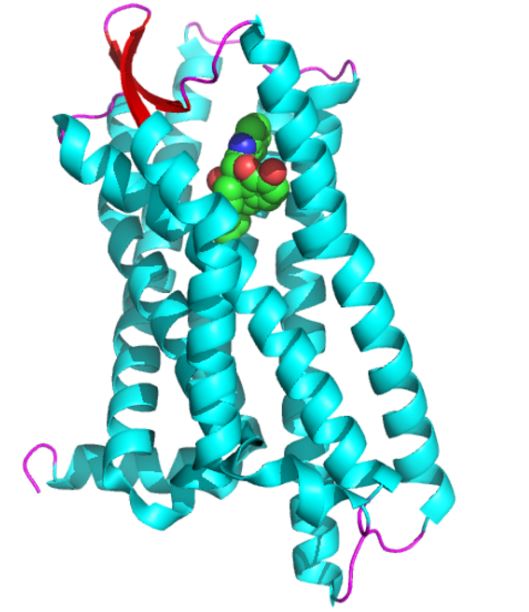Introduction of OPRD1
OPRD1 is encoded by the OPRD1 gene. OPRD1 is an inhibitory 7-transmembrane G-protein coupled receptor coupled to the G protein Gi/G0 and has enkephalins as its endogenous ligands. The regions of the brain where the δ-opioid receptor is largely expressed vary from species model to species model. In humans, the δ-opioid receptor is most heavily expressed in the basal ganglia and neocortical regions of the brain.
| Basic Information of OPRD1 | |
| Protein Name | Delta-type opioid receptor |
| Gene Name | OPRD1 |
| Aliases | Delta-type opioid receptor, D-OR-1, DOR-1 |
| Organism | Homo sapiens (Human) |
| UniProt ID | P41143 |
| Transmembrane Times | 7 |
| Length (aa) | 372 |
| Sequence | MEPAPSAGAELQPPLFANASDAYPSACPSAGANASGPPGARSASSLALAIAITALYSAVCAVGLLGNVLVMFGIVRYTKMKTATNIYIFNLALADALATSTLPFQSAKYLMETWPFGELLCKAVLSIDYYNMFTSIFTLTMMSVDRYIAVCHPVKALDFRTPAKAKLINICIWVLASGVGVPIMVMAVTRPRDGAVVCMLQFPSPSWYWDTVTKICVFLFAFVVPILIITVCYGLMLLRLRSVRLLSGSKEKDRSLRRITRMVLVVVGAFVVCWAPIHIFVIVWTLVDIDRRDPLVVAALHLCIALGYANSSLNPVLYAFLDENFKRCFRQLCRKPCGRPDPSSFSRAREATARERVTACTPSDGPGGGAAA |
Function of OPRD1 Membrane Protein
OPRD1 is well known for its analgesic potential, however, the exact role of OPRD1 receptor activation in pain modulation is largely up for debate. Activation of δ receptors produces analgesia, perhaps as significant potentiators of mu-opioid agonists. And DOR modulates the nociception of chronic pain. Another interesting aspect of δ-opioid receptor function is the suggestion of mu/delta opioid receptor interactions. Nevertheless, coexpression of receptors remains unique and potentially useful in the treatment of mood disorders and pain. Recent work indicates that exogenous ligands that activate the δ receptors mimic the phenomenon known as ischemic preconditioning.
 Fig.1 Structure of OPRD1 membrane protein
Fig.1 Structure of OPRD1 membrane protein
Application of OPRD1 Membrane Protein in Literature
This article demonstrates that chemically different agonists differ in their ability to phosphorylate, internalize, and/or down-regulate the DOR. Homologous regulation of the opioid receptor signaling is thought to play an important role in the development of opioid tolerance.
This article reports that tricyclic antidepressants show an analgesic effect in neuropathic and inflammatory pain that is blocked by theδ-opioid receptor antagonist naloxone. A compilation of the most significant studies will illustrate the actual and potential value of the opioid system for clinical research and drug development.
The article shows that high doses of the δ agonist peptide DPDPE produced respiratory depression in sheep. And the delta-selective agonist had multiple nonopioid adverse effects, whereas the mu-selective agonist was well tolerated by the pregnant ewe, suggesting that mu-selective agonists have better potential for clinical use as an analgesic in pregnancy.
This article reveals that the selective non-peptidic delta-opioid agonists SNC80 and (+) BW373U86 demonstrated antidepressant-like activity in the forced swim assay in rats.
This article is the first research to provide evidence that endogenous opioids can upregulate BDNF mRNA expression through the DOR and MOR, and that leu- and met-enkephalin have similar pharmacological profiles to synthetic DOR agonists in producing antidepressant-like effects.
OPRD1 Preparation Options
To obtain the soluble and functional target protein, the versatile Magic™ membrane protein production platform in Creative Biolabs enables many flexible options, from which you can always find a better match for your particular project. Aided by our versatile Magic™ anti-membrane protein antibody discovery platform, we also provide customized anti-OPRD1 antibody development services.
As a forward-looking research institute as well as a leading customer service provider in the field of membrane protein, Creative Biolabs has won good reputation among our worldwide customers for successfully accomplishing numerous challenging projects including generation of many functional membrane proteins. Please feel free to contact us for more information.
All listed services and products are For Research Use Only. Do Not use in any diagnostic or therapeutic applications.